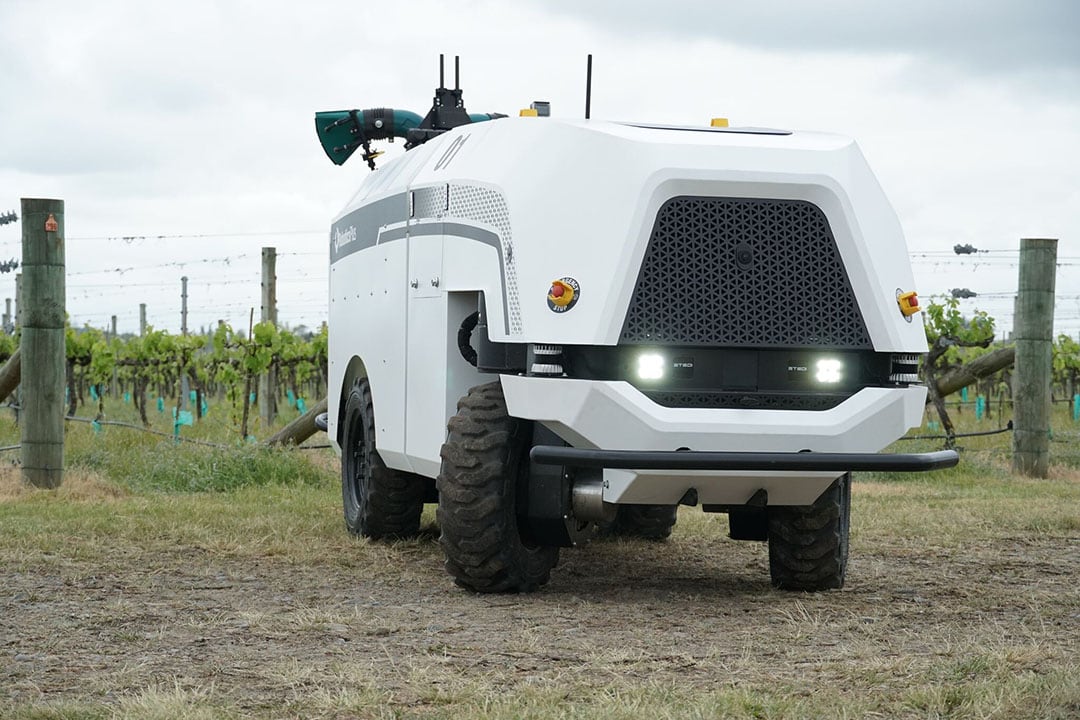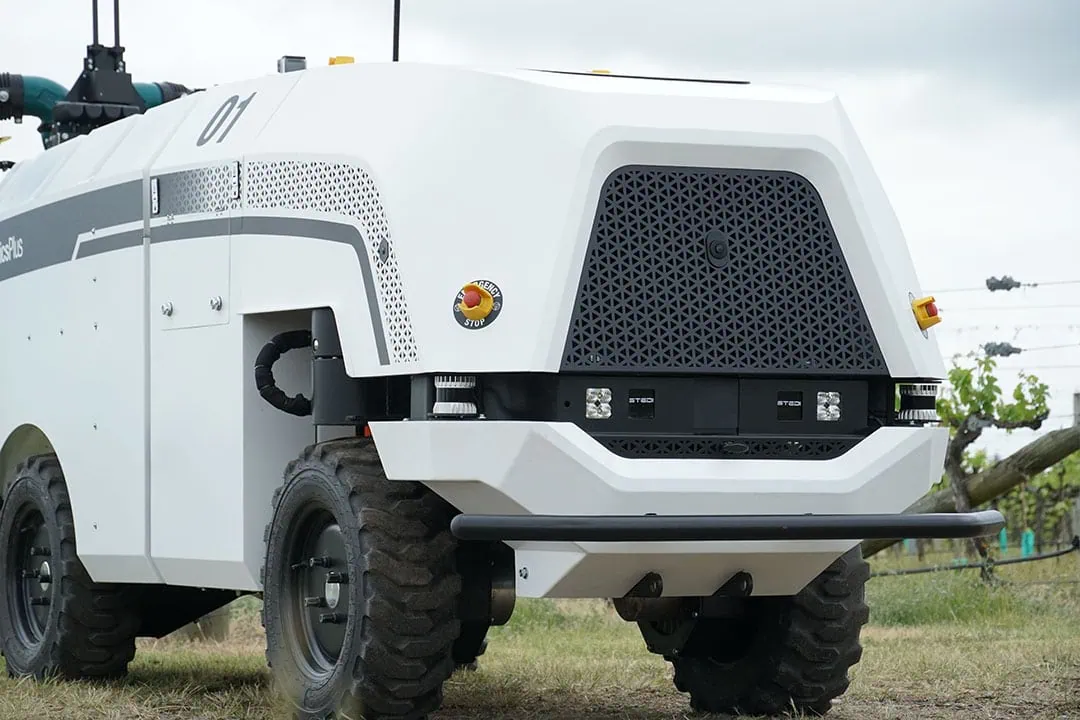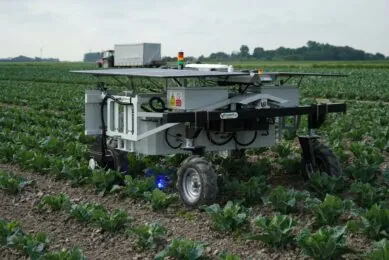Robotics Plus launches autonomous UGV for tree and vine crop tasks

New Zealand company Robotics Plus has launched its autonomous Unmanned Ground Vehicle (UGV) at FIRA USA 2022. The robot automates tree and vine crop tasks, starting with intelligent spraying.
The autonomous UGV – a modular vehicle that is available for pre-order – is designed to carry out a variety of orchard and vineyard machine tasks. The UGV can be supervised in a fleet of vehicles by a single human operator. It uses a combination of vision systems (LiDAR + cameras) and other technologies to optimise tasks and allow intelligent targeted application of inputs such as sprays.
Robotics Plus says eventually growers will be able to rotate multiple tools on the adaptable and configurable platform. “Depending on the day’s work – for jobs such as spraying, weed control, mulching, mowing and crop analysis.”
Steve Saunders, Co-founder and CEO of Robotics Plus, says its team worked alongside growers, researchers and technology suppliers to deliver the modular architecture for its multi-purpose autonomous UGV, which can operate in a range of environments.
“We’ve created a flexible agricultural platform with the power to adapt to different crop types with tools for various applications, providing year-round automation benefits and maximising machine utilisation.”
Also read: New Zealand’s Robotics Plus beta tests Unmanned Ground Vehicles
Intelligent spraying with autonomous UGV
The first application for the autonomous UGV is intelligent spraying. The system intelligently varies the flow rate to ensure spray efficacy whilst reducing inputs. Spray rates and airspeed are controlled in zones and respond as the sprayer moves along orchard or vineyard rows.
The spraytank has a volume of 1,500 litres/396 gallon. The Quantum QM-420 units are electrically driven by motors, giving an individual fan speed control up to 3,000 rpm. The application rate is 160 to 2,270 litres for a 3.5 metre orchard row. The pump has a maximum flow of 166-litre/43gallon per minute. The maximum pressure is 20 bar/290 PSI.
The spray units have electric proportional valve control to nozzle groups on each fan unit. This allows for precision control of an application rate on a per-fan basis. The rate is intelligently linked to the vehicle speed, preventing overspray.
Text continues below image

Autonomous UGV can be deployed in a range of applications in various crop types
The highly manoeuvrable UGV has a small footprint. Its steering configuration, incorporating electric steering and independent motors, increases productivity, according to Robotics Plus. “Allowing significantly more ground to be covered than machines which turn on every second row or greater, depending on row configuration.” The UGV can be deployed in a range of applications in various crop types with a minimum row spacing of 1.8M/6ft.
Electric drive motors give superior torque and control
Dr Alistair Scarfe, Co-founder and CTO of Robotics Plus, says the hybrid electric diesel UGV delivers outstanding performance in the field. “Electric drive motors give superior torque and control, whilst a Tier 4 diesel generator means the vehicle can operate for extended periods”, he points out. The run time of the UGV is approximately 12 hours, based on a single tank of fuel and operating conditions.
Fuel consumption is minimised by electrically driving all systems, including tools. Regenerative braking and high-capacity batteries also extend efficiency and range. “In addition, the vehicle’s lightweight design and intelligent all-wheel-drive system, with independent wheel motors, ensures grip and control – while significantly reducing ground compaction to protect the soil”, Mr Scarfe says.
Obstacle detection and avoidance
The robot has an electric drive system with an output of 55kW/74HP and uses regenerative breaking. The UGV can turn on the spot around the centre of the rear axle. It weighs 1,165kg/ 4,770lbs. The LiDAR coupled with cameras also delivers intelligent obstacle detection and avoidance.
The UGV can spray at a speed of 4-8km per hour. The top speed is limited by spray coverage. It has a top speed of 10km per hour in transit. The vehicle is able to roll up a lateral maximum slope of 10 degrees. A front bumper limits speed and helps to push safely through specific in-row obstacles such as long grass. The minimum headland for turning into an adjacent row is 6.4m/ 21ft.
Text continues below image

Designed to be modular and easy to service
The vehicle has been designed from the ground up to be modular and easy to service. With no hydraulic, gearbox or differential fluids to be managed, operators can keep their vehicles running if a part fails by simply swapping out modules when needed. This helps to reduce downtime and complexity for growers.
Mr Saunders emphasises that automation can help growers to adapt in a changing world and create a sustainable and competitive future in the agricultural sector. “Automation that solves real-world problems, reduces reliance on increasingly costly and hard-to-find machine operators and provides data-driven insights for informed decision-making.”
Our multi-purpose vehicle does much more than just replacing labour – it’s loaded with intelligence to improve efficiencies
Mr Saunders says that for automation to be adopted, it must also provide a good return on investment. “Our multi-purpose vehicle replaces tractors and other tools. But, it does much more than just replacing labour – it’s loaded with intelligence to improve efficiencies.”
Robotics Plus has partnered with Yamaha Motor Company, Autonomous Solutions Inc. and Croplands, to significantly increase the robustness and support for the product in a demanding environment such as agriculture.
“We’ve benefited from our partner’s deep knowledge and access to high-quality technology components. In addition, growers can deploy Quantum sprayers with configurations adaptable to various crop types, growing formats, and heights”, Mr Saunders says.
Extensive testing in New Zealand and the US
Robotics Plus’ fast-growing team developed the UGV at its Tauranga base, with extensive testing in New Zealand and the US in various environments and applications. Robotics Plus investors include Yamaha Motor Company and New Zealand’s ACC Impact Fund.
Join 17,000+ subscribers
Subscribe to our newsletter to stay updated about all the need-to-know content in the agricultural sector, two times a week.



